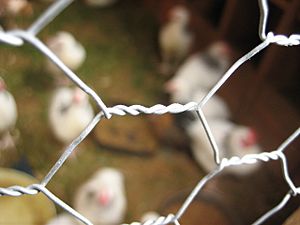Chicken wire facts for kids
Chicken wire, also called poultry netting, is a special kind of mesh made from thin wire. People often use it to build fences for fowl, like chickens, in their outdoor areas or coops.
This wire is usually made from galvanized steel, which means it has a protective zinc coating to stop it from rusting. It's flexible and has hexagonal (six-sided) holes. You can find chicken wire in different sizes, like 1 inch (about 2.5 cm), 2 inch (about 5 cm), and 1/2 inch (about 1.3 cm) wide holes. The wire itself also comes in different thicknesses, called "gauges," usually from 19 gauge (about 1 mm thick) to 22 gauge (about 0.7 mm thick).
Sometimes, people use chicken wire to make simple pens for small animals or to protect plants from animals. However, because the wire is thin and has zinc, it might not be suitable for animals that like to chew a lot. It also won't stop bigger predators from getting in.
In building projects, chicken wire is used as a base layer to hold cement or plaster, a technique called stuccoing. When concrete is strengthened with chicken wire, it creates a strong material called ferrocement. Artists also use chicken wire to create the basic shape, or "armature," for papier-mâché sculptures, especially when they need the sculpture to be quite strong.
History of Chicken Wire
The first machine to make wire netting was built in 1844 by Charles Barnard, a British ironmonger (someone who sells metal goods). He got his idea from machines that weave cloth. Soon, his company, Barnard, Bishop & Barnard in Norwich, was selling wire netting all around the world.
During World War II, the thin wire used for chicken wire had an important job. It was used to make large wire mats on the ground for radar systems. These mats helped the radar work better by making the ground reflections even. Because of this, there was a big shortage of chicken wire in the United Kingdom during the war.
German soldiers also commonly put chicken wire on their helmets during World War II. This helped them attach plants and branches to their helmets for camouflage, making them harder to spot.
Other Cool Uses
Chicken wire, especially the kind used in building, can sometimes block or weaken signals like Wi-Fi, cellular, and other radio waves. This happens because the wire can accidentally create something called a Faraday cage, which blocks electromagnetic fields.
Images for kids



